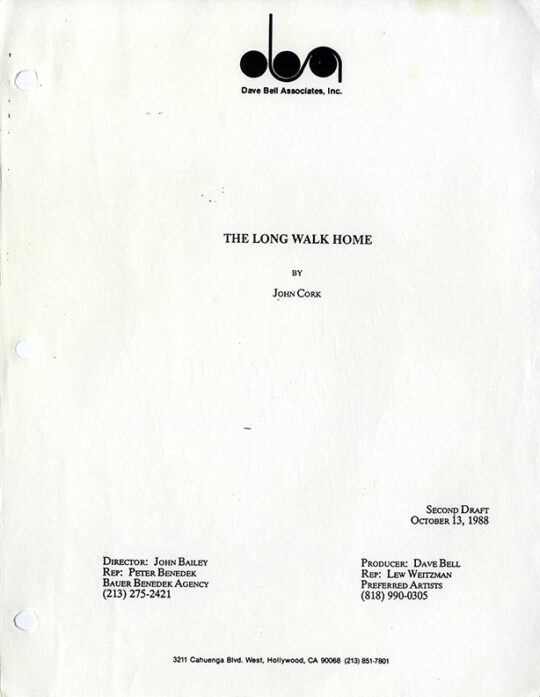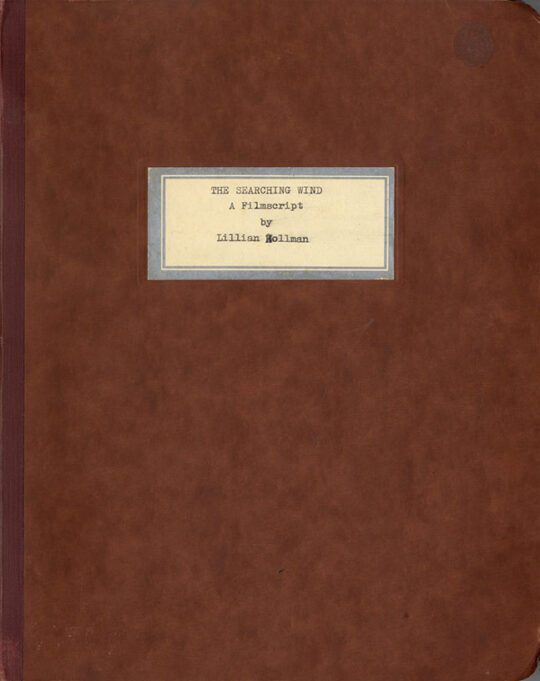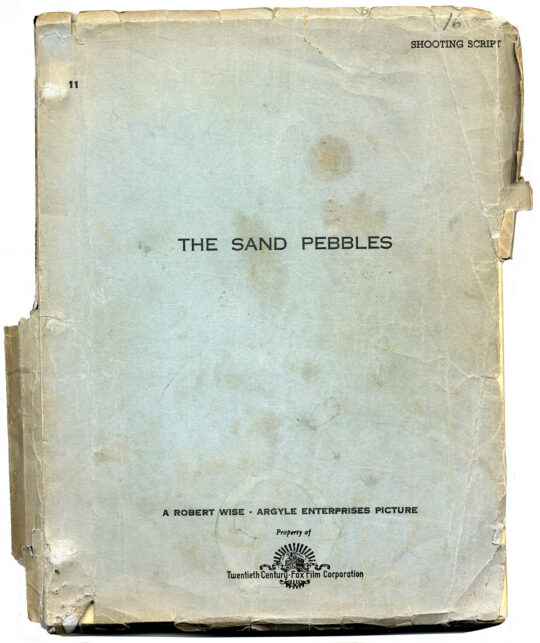CHINATOWN [ca. 1973] Jack Nicholson’s copy of early draft film script by Robert Towne
[Los Angeles]: Paramount Pictures, [ca. 1973]. Vintage original film script, printed die-cut Paramount Pictures wrappers, 11 x 8 1/2″ (28 x 22 cm.). First-generation xerographic printing, 187 pp. Pp. 178-187 are hand-numbered in ink. Light creasing to back cover, last few pages have minute stains at extreme top blank margins, overall near fine.
Jack Nicholson’s copy of a very early draft by Robert Towne. The script contains innumerable photocopied revisions, almost certainly in Towne’s hand, and some underlinings and notes in ink in Nicholson’s hand.
Almost all of the great American private eye films — The Maltese Falcon, Murder My Sweet, The Big Sleep, Out of the Past, Kiss Me Deadly — are adapted from preexisting works, with one outstanding exception: 1974’s Chinatown, based on an original screenplay by Robert Towne that is a masterpiece of narrative construction, meta-history, and myth.
This early draft of the Chinatown screenplay, with corrections by writer Towne and annotations by star Jack Nicholson, is substantially different from the screenplay that was eventually filmed — rougher and much longer. It has voiceover narration missing from the completed film. Where later versions of the screenplay — and the film — begin with the detective protagonist Jake Gittes (Nicholson) in conference with a cuckolded client (Burt Young), this version, set like the film in the 1930s, begins with the eventual murder victim, water commissioner Hollis Mulwray, examining the bed of the L.A. River.
What appear to be Towne’s photocopied annotations are essentially corrections (portions of lines crossed out, many hand-printed words added to the dialogue), suggesting this is an early draft, if not the first draft, of the completed script. What appear to be Nicholson’s annotations, handwritten in this copy, are comments suggesting a dialogue between Towne and Nicholson (who had been friends and collaborators for many years) regarding the development of the script. The screenplay was clearly written with Nicholson in mind as the lead.
Although the movie is much tighter than this early draft, and scenes have been revised, replaced, or rearranged, the bare bones of the plot are the same as in all later versions — the mystery of why massive amounts of L.A.’s water are being diverted into the ocean, the strange interrelationship of water engineer Hollis Mulwray and his beautiful wife Evelyn Mulwray (Faye Dunaway), her monstrously wealthy father and Hollis’s former partner Julian Cross (renamed Noah Cross and played by John Huston in the movie), and the incest theme, the hidden girl who turns out to be Evelyn’s daughter by her own father.
Between this draft and the completed film, some characters were added and others eliminated. Unlike in the movie, the screenplay’s patriarchal villain, Julian Cross, doesn’t appear until late in the story. And he has far fewer scenes and lines. The most radical difference between this draft, subsequent drafts, and the completed film is its final act and conclusion. In this early draft, Cross, the man behind it all, is shot dead by Evelyn off-screen — whereas in the completed movie’s stunning ending (written by director Roman Polanski), Evelyn is the one who is shot and Cross leaves the scene with Evelyn’s terrified daughter in his custody. Evil and corruption prevail.
In stock
Related products
-

LONG WALK HOME, THE (Oct 13, 1988) Second draft film script by John Cork
$375.00 Add to cart -
![LES CREATURES [THE CREATURES] (1966) French film script](https://www.walterfilm.com/wp-content/uploads/2021/04/LesCreaturesSCR_a-540x689.jpg)
Agnès Varda (screenwriter, director) LES CRÉATURES (1966) Film script
$1,500.00 Add to cart -

SEARCHING WIND, THE (Nov 7, 1946) Final White script by Lillian Hellman
$1,500.00 Add to cart -

SAND PEBBLES, THE (Nov 1, 1965) Shooting script by Robert Anderson
$1,150.00 Add to cart

![CHINATOWN [ca. 1973] Jack Nicholson's copy of early draft film script by Robert Towne](https://www.walterfilm.com/wp-content/uploads/2024/06/ChinatownSCR_a.jpg)
![CHINATOWN [ca. 1973] Jack Nicholson's copy of early draft film script by Robert Towne - Image 2](https://www.walterfilm.com/wp-content/uploads/2024/06/ChinatownSCR_b.jpg)
![CHINATOWN [ca. 1973] Jack Nicholson's copy of early draft film script by Robert Towne - Image 3](https://www.walterfilm.com/wp-content/uploads/2024/06/ChinatownSCR_c.jpg)
![CHINATOWN [ca. 1973] Jack Nicholson's copy of early draft film script by Robert Towne - Image 4](https://www.walterfilm.com/wp-content/uploads/2024/06/ChinatownSCR_d.jpg)